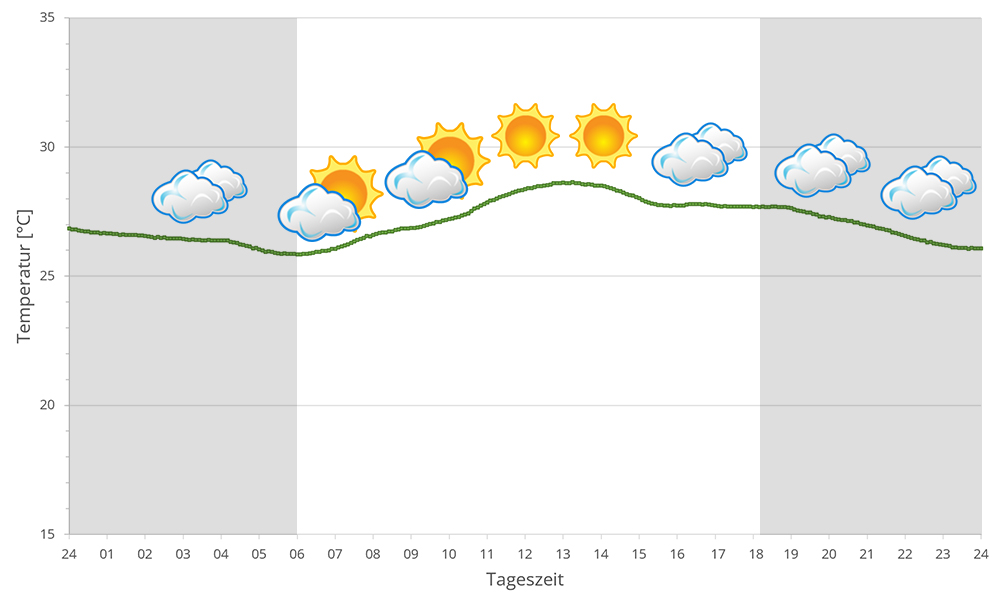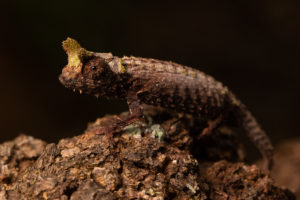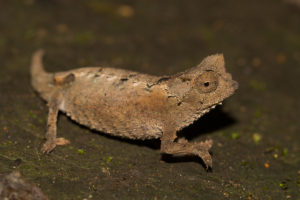no legal export possible
First description:
Rakotoarison, Hasiniaina, Glaw and Vences, 2024 ![]()
Origin of the species name:
The biologist Andolalao Rakotoarison named the species after the Malagasy word for dream. On the one hand, this fits its origin, the ‘nest of dreams’. However, the scientist also considered it a dream that the small leaf chameleon is found in a protected area at all, as the eastern lowland rainforests are extremely threatened by deforestation.
Distribution:
As the name suggests, these leaf chameleons live on the central east coast of Madagascar in the Akanin’ny Nofy reserve around the lodge of the same name. The lowland rainforest lies directly on Lake Ampitabe and only a few hundred metres as the crow flies from the Indian Ocean, just above sea level. Brookesia nofy is also found in the neighbouring protected area of Vohibola. Like all terrestrial chameleons of the subgenus Evoluticauda, its distribution area is therefore relatively small. They are found at the foot of large trees between the roots and in the thick foliage layer of the lowland rainforest. At night, they sleep on blades of grass or thin plants just above the ground.
Appearance & size:
 Brookesia nofy grow to a maximum length of 33 mm from the nose to the tip of the tail. These leaf chameleons are light brown to beige in colour. On the back of the head it has two low bony crests, which are bordered by a U-shaped low ridge behind and on the sides. The tail has no lateral or dorsal protruding spines, but instead of a pelvic shield, the small chameleons have an enlarged pelvic spine. Brookesia nofy is related to Brookesia ramanantsoai from the eastern highlands of Madagascar. B. ramanantsoai are larger than B. nofy. They also differ in tail length and head size. Earth chameleons of the species B. ramanantsoai also have three relatively parallel low bony ridges on the back of the head, but none running transversely behind them.
Brookesia nofy grow to a maximum length of 33 mm from the nose to the tip of the tail. These leaf chameleons are light brown to beige in colour. On the back of the head it has two low bony crests, which are bordered by a U-shaped low ridge behind and on the sides. The tail has no lateral or dorsal protruding spines, but instead of a pelvic shield, the small chameleons have an enlarged pelvic spine. Brookesia nofy is related to Brookesia ramanantsoai from the eastern highlands of Madagascar. B. ramanantsoai are larger than B. nofy. They also differ in tail length and head size. Earth chameleons of the species B. ramanantsoai also have three relatively parallel low bony ridges on the back of the head, but none running transversely behind them.
| Jan | Feb | Mär | Apr | Mai | Jun | Jul | Aug | Sep | Okt | Nov | Dez | |
| Durchschnittl. Temperatur | 26 | 26 | 26 | 25 | 24 | 22 | 21 | 21 | 22 | 23 | 25 | 26 |
| Minimale Temperatur | 22 | 23 | 21 | 19 | 17 | 17 | 17 | 17 | 18 | 19 | 21 | 22 |
| Maximale Temperatur | 30 | 30 | 30 | 29 | 28 | 26 | 25 | 27 | 26 | 27 | 29 | 30 |
| Regentage | 20 | 19 | 20 | 15 | 14 | 13 | 16 | 15 | 13 | 13 | 15 | 19 |
Die angegebenen Daten wurden von uns innerhalb mehrerer Jahre mit Thermo- und Hygrometern direkt an den Fundorten der Tiere gemessen und zusammengetragen. "Durchschnittliche Temperatur" bedeutet, dass die Werte eines gesamten Monats zu einem Durchschnittswert berechnet wurden, z.B. wurden alle gemessenen Minimalwerte eines Monats zu einem durchschnittlichen Minimalwert für Februar berechnet. Das bedeutet im Klartext, dass einzelne Spitzenwerte eines Tages deutlich höher oder niedriger als die durchschnittlichen Minimal- und Maximalwerte liegen können. Es ist also möglich, dass zwar das durchschnittliche Maximum bei 29 Grad liegt, es aber an einigen Tagen des Monats 33°C oder gar 35°C warm war.
Zwei Beispiele für einen Tagesverlauf der Temperaturen rund um den See Ampitabe in der Regenzeit finden sich im Folgenden. Beide wurden 2023 mit Datenloggern aufgezeichnet.


Das Klima am See Ampitabe und in Manambato ist ganzjährig warm, und der nahe Indische Ozean bringt meist eine leichte Brise mit sich. Deshalb ist dies ein beliebter Entspannungsort für Reisende - kalt wird es hier nie. Tagsüber können die Temperaturen gut die 30°C übersteigen, in der Trockenzeit von April bis Oktober liegen sie geringfügig niedriger.
Nachts kühlen die Temperaturen etwas ab. Weit unter 20°C geht die Nachttemperatur jedoch nie. Das ganze Jahr über fällt moderat viel Niederschlag, so dass der Regenwald stetig grün bleibt. 2023 haben wir mit Datenloggern die relative Luftfeuchtigkeit an verschiedenen Tagen rund um den See Ampitabe in der Regenzeit gemessen, die Daten finden sich im Folgenden.



Die UVB-Daten wurden mit einem Solarmeter 6.5 im Frühjahr (Anfang April) zur höchsten Aktivitätszeit der Chamäleons gemessen. Gemessen wurden jeweils maximal für das Chamäleon zu erreichende Werte im Habitat.
2023 haben wir zusätzlich zu anderen Klimadaten auch den Luftdruck an den von uns besuchten Orten auf Madagaskar gemessen. Die folgenden Daten stammen von verschiedenen Tagen während der Regenzeit rund um den See Ampitabe. Auf der X-Achse befindet sich die Tages- oder Nachtzeit. Auf Madagaskar beginnt der Tag gegen 6 Uhr, die Nacht bricht bereits um 18 Uhr an. Die Y-Achse zeigt den atmosphärischen Luftdruck in hPa an.


Habitat:
The following photos show further sections of the habitat of Brookesia nofy during the rainy and dry seasons in the Akanin’ny Nofy reserve. Some are taken directly from the species’ habitat. The rainforest here consists of many slender, rather young trees, many lianas, mosses and ferns. The soil here is very sandy due to its proximity to the coast. Brookesia nofy colonises damp microhabitats at the roots of trees. Further up in the same habitat, Parson’s Chameleons and Calumma vohibola as well as the local form Ampitabe of the panther chameleons can also be found.
Below you will find some 360° images from Akanin’ny Nofy that we took during the rainy season. If you click on the respective image, the pictures will open in an enlarged view in a separate window. You can use the mouse to rotate in all directions. You also have the option of running the images in full-screen mode. Enjoy!
































